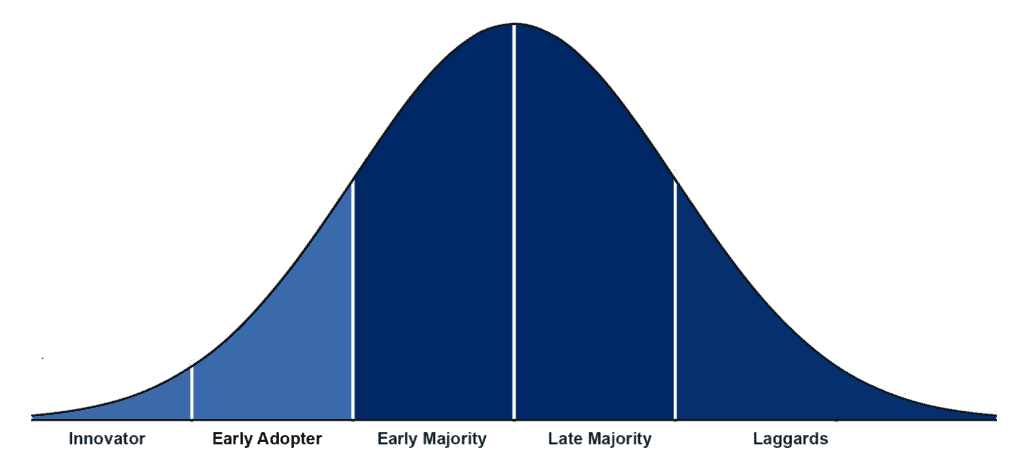Early adopters play a significant role in the beginnings of your high-tech company. In order for high-tech products to achieve mass market appeal, they must be refined and improved by a sequence of users, starting with innovators and early adopters. This dynamic, called Diffusion of Innovation, is critical to the success of any emerging high-tech product or technology. Without the adaptation and improvement that’s demanded by early users, mainstream customers (over 80% of the market) will not adopt your new idea or device.
 According to diffusion theory, early adopters are the second wave of product purchasers following innovators. These tend to be the most influential people within any market space and they are driven by a dream.
According to diffusion theory, early adopters are the second wave of product purchasers following innovators. These tend to be the most influential people within any market space and they are driven by a dream.
Early Adopter Characteristics
Founders of high-tech companies typically excel at painting a vision of how their new innovation can change the world. They are used to talking about all of the wonderful things that can happen if you adopt their product. Early adopters are attracted to this vision and they tend to possess many of the same fundamental characteristics. The mindset and messaging of high-tech startups are inspiring for early adopters.
The earliest adopters of new technology are able to visualize the promised outcome. They understand your product’s economic and environmental promise and its potential to transform society. While they still seek some return on their investment, they are also optimists — they believe your technology will work as expected and move us toward a better way of living. They overlook the rough edges and potential challenges of being among the first and jump into high-tech markets early.
Later adopters, on the other hand, will demand more development, support, standards, and near perfection. Therefore, it’s important to jumpstart your company by finding people who will love your early-stage product or idea; people who can help you improve your high-tech product over time.
When taking your high-tech product to market, early adopters can be your biggest supporters, friends and allies provided you remember one thing: visionaries are not looking for gradual improvement, they are looking for a fundamental breakthrough. Early adopters are people who have the insight to match a new technology to a strategic opportunity, combined with the temperament to translate that insight into a high-visibility project.
These “change the world” characteristics of early adopters can literally launch your high-tech company. Early adopters sometimes represent a hidden source of financial capital, and always bring much-needed visibility to your high-tech startup.
Mainstream Customers Avoid Risk
Unfortunately all methods of marketing to early adopters will fail miserably for you in the future. The visionary characteristics of your early customers are in direct opposition to the characteristics of mainstream customers. Instead of looking at how a new technology can create a strategic leap forward, mainstream buyers of have a more pragmatic view of the world and they worry about all of the things that could possibly go wrong if they adopt your new product.
This means moving from early adopters to mainstream customers is a big jump.
Here are four ways the characteristics of early adopters help make a high-tech business strong, but then hurt your company as it transitions to serving the mass market or mainstream population:
1) help: Early adopters are happy to be the first to try something that no one else is using. This is because visionaries don’t like each other and are happy to go it alone. They see themselves as smarter than people in the same position in other organizations or companies, so they don’t value the experience of colleagues.
hurt: The mainstream sees this as foolish because they place a very high value on the experience of colleagues.
2) help: Early adopters tend to take greater interest in technology than they do in their industry. They are bored with the details of their own industry and want to discuss emerging technology with people from different industries.
hurt: Mainstream buyers would rather stay within the boundaries of their own industry and require references from inside, not outside.
3) help: Early adopters often fail to recognize the importance of the existing market infrastructure. They move forward without supporting standards or independent safeguards.
hurt: People in the mainstream use the standards and other community-based assets in order to be compatible, so that the industry as a whole can be productive.
4) help: Early adopters are generally disruptive and are happy to challenge the status quo with a breakthrough technology. If their world-changing project fails, they move on to the next one, leaving those left behind to clean up the mess.
hurt: The mainstream buyer wants gradual improvement that doesn’t cause disruption.
To boost the initial sales of your new product or technology, you must use “the language of early adopters” to attract and sell to this initial segment of the market.
Remember that just as your high-tech company has learned how to market and sell to early adopters, a big shift in customer characteristics occurs and you must re-learn everything.
Early majority and mainstream customers are less concerned with the vision, or leadership, or making a quantum leap, and more concerned with the practical results. In approaching a new set of customers with a different mindset, startups have to be ready to look at their entire strategy — product, messaging, and distribution — with a fresh perspective, and be willing to embrace change across the board.

